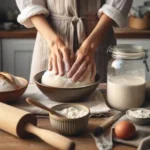There’s something undeniably magical about the scent of fresh bread wafting through your home, a warm embrace that evokes comfort and nostalgia.
Baking homemade bread is an art that combines simple ingredients with a touch of love and patience, resulting in a delightful creation that can elevate any meal or stand alone as a satisfying snack. In this ultimate guide, we’ll delve into the essential tips and techniques that will transform your kitchen into a haven of irresistible aromas and golden crusts. Whether you’re a novice baker or looking to refine your skills, this comprehensive resource will walk you through the fundamentals of bread-making—from selecting the right flour and mastering the perfect knead to achieving that sought-after crust and tender crumb. Join us on this delicious journey and discover how to bake perfect homemade bread that will impress family and friends alike, and leave you craving for more!
1. Introduction: The Joy of Baking Bread at Home

Baking bread at home is more than just a culinary endeavor; it’s a delightful journey that engages all your senses and nourishes the soul. The warm, inviting aroma of freshly baked bread wafting through your kitchen has a way of creating an atmosphere of comfort and nostalgia. For many, the simple act of kneading dough and watching it rise can be a form of meditation, a moment of stillness in our fast-paced lives.
Imagine the satisfaction of pulling a golden loaf from the oven, the crust crackling as it cools, and the first slice revealing a tender, fluffy interior. Each bite carries the essence of your personal touch—whether it’s the choice of ingredients you’ve selected, the herbs and spices you’ve added, or the unique techniques you’ve employed. Baking your own bread allows for creativity and experimentation, transforming basic ingredients like flour, water, yeast, and salt into something extraordinary.
Moreover, baking bread at home fosters a sense of accomplishment. There’s a profound joy in mastering the art of bread-making, from understanding the science behind fermentation to perfecting your kneading technique. It’s an opportunity to connect with a long-standing tradition that has been cherished across cultures and generations. In this guide, we will explore essential tips and techniques to help you navigate the world of homemade bread with confidence, ensuring that each loaf you create is not just good, but truly perfect. So, let’s roll up our sleeves, dust the counter with flour, and embark on this rewarding baking adventure together!
2. Essential Tools and Equipment for Bread Baking
Baking bread at home can be a rewarding experience, but having the right tools and equipment is crucial to achieving that perfect loaf. Let’s delve into the essentials you’ll need to embark on your bread-baking journey.
**1. Mixing Bowls:** A set of sturdy mixing bowls in various sizes is fundamental. Opt for glass or stainless steel, as they are durable and won’t absorb odors. A large bowl is ideal for mixing your dough while smaller bowls can help with ingredient prep.
**2. Kitchen Scale:** Precision is key in baking, and a kitchen scale allows for accurate measurements of flour, water, and other ingredients. This is especially important in bread-making, where the balance of ingredients can significantly affect the texture and rise of your loaf.
**3. Dough Scraper:** This simple yet effective tool is invaluable for handling sticky dough. A dough scraper helps you mix, knead, and shape your bread without making a mess. It’s also perfect for portioning your dough into equal sizes for rolls or loaves.
**4. Stand Mixer with Dough Hook:** While mixing by hand is a time-honored tradition, a stand mixer equipped with a dough hook can save you time and effort, especially for large batches. The mixer kneads the dough efficiently, providing the necessary gluten development for a perfect loaf.
**5. Proofing Basket:** Also known as a banneton, this tool helps shape your dough as it proofs, creating a beautiful swirl pattern on your loaf. It allows for better moisture retention, which is crucial for achieving a crispy crust. If you don’t have one, a bowl lined with a floured kitchen towel will work in a pinch.
**6. Baking Stone or Steel:** For a crusty, artisan-style bread, investing in a baking stone or steel can make all the difference. These tools retain heat exceptionally well, helping to create a professional-quality crust by simulating the conditions of a traditional bread oven.
**7. Oven Thermometer:** Home ovens can often be inaccurate, resulting in uneven baking. An oven thermometer will ensure that your bread bakes at the correct temperature, providing consistency and helping you avoid undercooked or burnt loaves.
**8. Lame or Sharp Knife:** Scoring your bread before baking not only allows for proper expansion but also enhances the aesthetic appeal of your loaf. A lame (a specialized bread knife) or a sharp kitchen knife will give you clean cuts, ensuring a beautiful rise.
**9. Cooling Rack:** once your bread is out of the oven, it needs to cool properly to prevent sogginess. A cooling rack allows air to circulate around the bread, maintaining its crisp crust and fluffy interior.
With these essential tools in your baking arsenal, you’ll be well-equipped to tackle any bread recipe that comes your way. Remember, the right equipment not only makes the process easier but also enhances the quality of the bread you create. Happy baking!
3. Understanding Ingredients: Flour, Yeast, Water, and Salt

### Understanding Ingredients: Flour, Yeast, Water, and Salt
The foundation of any great homemade bread lies in its core ingredients: flour, yeast, water, and salt. Each component plays a crucial role in the baking process, and understanding their functions can significantly improve your results.
**Flour** is the backbone of your bread. Different types of flour have varying protein content, which affects gluten development—the key to achieving that desirable chewy texture. All-purpose flour is versatile and suitable for most bread recipes, while bread flour, with its higher protein content, enhances gluten strength for a chewier crust. Whole wheat flour adds a nutty flavor and earthy texture but often requires additional hydration due to its bran content. Experimenting with different flours can lead to delightful variations in flavor and texture.
**Yeast** is the magical organism that brings your dough to life. When activated, yeast ferments the sugars in the flour, producing carbon dioxide gas that causes the dough to rise. There are primarily two types of yeast used in bread-making: active dry yeast and instant yeast. Active dry yeast requires proofing in warm water before use, while instant yeast can be mixed directly into the dry ingredients. Understanding the right amount and type of yeast to use is essential, as it influences both the rise and flavor of your bread.
**Water** is often an underestimated ingredient but is vital in the baking process. It hydrates the flour, allowing gluten to develop and facilitating yeast fermentation. The temperature of the water matters; too hot can kill the yeast, while too cold can inhibit its activity. A good rule of thumb is to use water around 100°F (37°C) for optimal yeast activation. You may also want to consider the mineral content of your water, as certain minerals can enhance the flavor and texture of the bread.
**Salt** is not just a flavor enhancer; it also strengthens gluten structure and helps regulate yeast activity. Without it, your bread would be bland and dense. However, too much salt can hinder yeast fermentation, so finding the right balance is crucial. Typically, a ratio of 1.5-2% salt to the weight of flour is a good starting point. It’s also important to mix salt into the dry ingredients before adding the yeast, as direct contact with yeast can inhibit its growth.
By understanding the roles of flour, yeast, water, and salt, you can experiment with different combinations and techniques. Each ingredient not only impacts the flavor and texture of your bread but also influences how well your dough rises and bakes. So, embrace the science behind these essentials, and let them guide you on your journey to baking perfect homemade bread.
4. The Science of Bread: How Ingredients Work Together
Understanding the science behind bread-making is essential for creating that perfect loaf that boasts a crusty exterior and a soft, airy crumb. Each ingredient plays a vital role in this intricate dance of flavors and textures, and knowing how they interact can elevate your baking to new heights.
**Flour:** The foundation of any bread, flour provides the structure. Most bread recipes call for all-purpose or bread flour, which has a higher protein content than regular flour. This protein, primarily gluten, develops when mixed with water and kneaded, forming a network that traps gases produced by yeast. The result? A loaf that rises beautifully and holds its shape.
**Water:** Often underestimated, water is crucial not just for hydration but also for activating the yeast and dissolving the flour’s proteins. The temperature of the water matters, too—warm water (around 100°F) encourages yeast activity, while cold water can slow it down. The right balance of moisture is key; too much can make the dough sticky and unmanageable, while too little can lead to a dry loaf.
**Yeast:** The magical ingredient that allows bread to rise, yeast ferments the sugars present in the flour, producing carbon dioxide gas. This gas expands within the gluten network, causing the dough to rise. Different types of yeast, such as active dry, instant, or fresh yeast, can affect the fermentation time and flavor profile of your bread. Understanding how to properly activate and incorporate yeast can make all the difference in your final product.
**Salt:** Often viewed as just a seasoning, salt is a crucial player in bread-making. It not only enhances flavor but also tightens the gluten structure, providing better elasticity and texture. Additionally, salt helps to control yeast activity, preventing it from fermenting too quickly, which can lead to an unbalanced flavor.
**Sugar:** While not always necessary, sugar contributes to the bread’s flavor and helps with browning during baking. It serves as food for the yeast, promoting fermentation, and can enhance the overall texture of the bread. Some recipes call for additional sweeteners like honey or molasses, which can impart unique flavors and moisture.
By grasping how these ingredients work together, you can experiment with proportions and techniques to achieve your desired outcome. Whether you prefer a crusty baguette or a soft sandwich loaf, understanding the science behind your ingredients will empower you to bake with confidence and finesse, ensuring that each loaf is a delicious success. Happy baking!
5. Choosing the Right Type of Bread to Bake

Choosing the right type of bread to bake is a crucial step in your journey to becoming a home baking maestro. With a myriad of options available, from crusty sourdough loaves to soft brioche, the choice can feel overwhelming. However, understanding the characteristics and techniques involved in each type of bread can help you select the perfect recipe that aligns with your skill level and desired outcome.
If you’re new to baking, starting with a simple white bread or a basic whole wheat loaf can set a solid foundation. These recipes typically require fewer ingredients and less intricate techniques, allowing you to build confidence as you master the basics of mixing, kneading, and proofing. On the other hand, if you’re feeling adventurous, consider venturing into the realm of artisan breads, such as ciabatta or focaccia. These breads often feature unique flavors and textures, and while they may require a bit more skill and patience, the reward of pulling a beautifully crusty loaf from the oven is well worth the effort.
For those who have dietary restrictions or preferences, there are also a variety of gluten-free, dairy-free, and whole grain options to explore. Each type of bread brings its own set of challenges and flavor profiles. For instance, gluten-free breads often require a blend of flours and additional binding agents to achieve the right texture, while whole grain breads tend to be denser, offering a rustic flavor that many find appealing.
Ultimately, the best approach is to choose a bread that excites you. Whether your heart is set on a classic baguette, a sweet cinnamon roll, or a hearty rye, select a recipe that speaks to your taste buds and inspires your baking endeavors. Embrace the journey of experimentation—after all, each loaf you bake will bring you one step closer to mastering the art of homemade bread. Happy baking!
6. Step-by-Step Guide to Making Basic Bread Dough
Making basic bread dough is the cornerstone of any successful baking journey, and with a little patience and practice, you can master this fundamental skill. Here’s a step-by-step guide to help you create a delicious loaf that will impress both your taste buds and your family.
**Step 1: Gather Your Ingredients**
Start with the essentials: flour, water, yeast, and salt. For a typical loaf, you’ll need about 4 cups of all-purpose flour, 1 and ½ cups of warm water (around 110°F), 2 teaspoons of active dry yeast, and 1 tablespoon of salt. Using high-quality ingredients is crucial, as they will significantly impact the final taste and texture of your bread.
**Step 2: Activate the Yeast**
In a small bowl, combine the warm water with the yeast and a pinch of sugar. Let it sit for about 5-10 minutes until it becomes frothy. This step is essential as it proves that your yeast is alive and ready to work its magic, creating the rise that gives bread its airy structure.
**Step 3: Mix the Dough**
In a large mixing bowl, combine the flour and salt. Make a well in the center and pour in the activated yeast mixture. Using a wooden spoon or your hands, start mixing until the dough comes together. You may need to add a little more flour or water, depending on the humidity and the absorbency of your flour. The goal is to achieve a slightly sticky, yet manageable dough.
**Step 4: Knead the Dough**
Once the dough forms a cohesive ball, transfer it to a floured surface. Knead the dough for about 8-10 minutes, folding and pushing it with the heel of your hand. This process develops gluten, which gives your bread its structure and chewiness. You’ll know it’s ready when the dough is smooth and elastic, bouncing back when poked.
**Step 5: First Rise**
Shape the kneaded dough into a ball and place it in a lightly greased bowl, covering it with a damp cloth or plastic wrap. Set it in a warm, draft-free area to rise for about 1 to 2 hours, or until it has doubled in size. This step is crucial, as it allows the yeast to ferment and produce carbon dioxide, resulting in a light, airy loaf.
**Step 6: Shape the Dough**
Once the dough has risen, gently punch it down to release the air. turn it out onto a floured surface and shape it into a loaf or divide it into smaller portions for rolls. Place the shaped dough into a greased loaf pan or on a baking sheet lined with parchment paper.
**Step 7: Second Rise**
Let the shaped dough rise again for about 30-60 minutes, covered with a cloth. This second rise helps to improve the texture and flavor of the bread, so be patient and allow it to puff up nicely.
**Step 8: Bake**
Preheat your oven to 375°F (190°C) while the dough rises. Once ready, bake the bread for 30-35 minutes, or until it sounds hollow when tapped on the bottom and has a beautiful golden-brown crust. If you want a crustier loaf, place a shallow pan of water in the oven while it bakes to create steam.
**Step 9: Cool and Enjoy**
After baking, remove
7. Kneading Techniques: Achieving the Perfect Texture

Kneading is one of the most crucial steps in the bread-making process, as it develops the gluten that gives bread its structure and chewy texture. Mastering the art of kneading can mean the difference between a dense loaf and one that is light and airy. Whether you choose to knead by hand or use a stand mixer, understanding the techniques involved can elevate your homemade bread to new heights.
**Hand Kneading:** If you prefer the traditional approach, hand kneading can be a meditative experience. Start by flouring your work surface and your hands to prevent sticking. Gather your dough into a rough ball, and with the heel of your hand, push the dough away from you. Fold it back over itself, give it a quarter turn, and repeat the process. This rhythmic motion helps align the gluten strands and incorporates air into the dough. Aim for about 8 to 10 minutes of kneading until the dough becomes smooth and elastic. To test if you’ve kneaded enough, perform the “windowpane test”: stretch a small piece of dough between your fingers. If it stretches into a thin, translucent membrane without tearing, you’re good to go!
**Using a Stand Mixer:** If you’re short on time or prefer a hands-off approach, a stand mixer can do the heavy lifting for you. Equip your mixer with the dough hook, and mix your ingredients on low speed until they come together. Gradually increase the speed to medium and let the machine knead the dough for about 5 to 7 minutes. Just like with hand kneading, the dough should be smooth and elastic when it’s ready. Keep an eye on the texture; if it appears too sticky, add a little flour, but be cautious not to overdo it, as too much flour can lead to a dry loaf.
**Resting Time:** After kneading, it’s essential to let your dough rest. This resting period allows the gluten to relax, making it easier to shape later on. Cover the dough with a damp cloth or plastic wrap and let it rise in a warm, draft-free area until it has doubled in size—usually about 1 to 2 hours, depending on the recipe.
By mastering these kneading techniques, you’ll not only achieve the perfect texture for your bread but also deepen your appreciation for the craft of baking. The satisfaction of pulling a beautifully risen loaf from the oven, with that inviting golden crust and soft, airy interior, is well worth the effort!
8. The Importance of Proofing: How to Get It Right
Proofing is a crucial step in the bread-making process that can dramatically influence the texture and flavor of your loaf. At its core, proofing is the final rise of your shaped dough before it goes into the oven. During this time, yeast continues to ferment, producing carbon dioxide that causes the dough to expand and develop an airy structure. However, getting this stage right requires a delicate balance of time, temperature, and technique.
To achieve the perfect proof, start by shaping your dough into the desired form—whether it’s a rustic round loaf, a braided challah, or a classic baguette. Once shaped, place your dough in a lightly greased bowl or on a floured surface, and cover it with a damp cloth or plastic wrap to prevent it from drying out. The ideal environment for proofing is a warm, draft-free area, typically between 75°F to 85°F (24°C to 29°C). If your kitchen is on the cooler side, consider placing the dough in an oven with the light on or near a slightly warmed stovetop.
Timing is key during proofing. While a general guideline is to let the dough rise until it has doubled in size, this can vary based on the type of bread, the ingredients used, and even the humidity level in your kitchen. A great way to check for readiness is to perform the “poke test”: gently press your finger into the dough. If the indentation springs back slowly, your dough is ready to go. If it springs back quickly, it needs more time; if it doesn’t spring back at all, it may be over-proofed.
Don’t underestimate the importance of this step—proper proofing not only enhances the bread’s flavor through the development of natural sugars but also ensures a light, airy crumb. So, as you embark on your bread-baking journey, remember that patience and attention to detail during the proofing stage will reward you with a delicious homemade loaf that’s worthy of celebration.
9. Shaping Your Dough: Techniques for Different Bread Styles
Shaping your dough is an art that can significantly influence the texture and appearance of your homemade bread, and mastering different techniques will allow you to create a variety of styles, each with its unique character. Whether you’re aiming for the rustic charm of a sourdough boule or the elegant, tight crumb of a baguette, the way you shape your dough plays a crucial role in the final product.
**1. The Round Boule:** To create a round boule, start by lightly flouring your work surface. Gently flatten your risen dough into a rectangle using your fingertips, then fold the edges towards the center, creating a tighter surface. Flip the dough over, seam side down, and use your hands to cup the dough, rotating it on the surface to create tension. This technique not only gives your loaf a lovely shape but also helps the dough to rise evenly.
**2. The Baguette:** Shaping a baguette requires a bit more finesse. Begin by dividing your dough into equal portions. Gently flatten each piece and use a rolling pin to elongate it, being careful not to deflate the air pockets too much. Once you have a long, tapered shape, roll it tightly, starting from one end, and seal the seam well. The key to a good baguette is creating a tight surface that will hold its shape during the second rise, ensuring a beautiful crust when baked.
**3. The Focaccia:** Focaccia is one of the easiest breads to shape, as its rustic style embraces a more relaxed form. After your dough has risen, simply press it into a well-oiled baking sheet, using your fingers to create dimples all over the surface. This not only creates an inviting texture but also allows olive oil and toppings to seep into the dough as it bakes, resulting in a flavorful crust.
**4. The Sandwich Loaf:** For a classic sandwich loaf, shape your dough into a rectangle and roll it tightly, ensuring that each layer is compact. Pinch the seams closed and place it seam side down in a greased loaf pan. This method provides structure and height, giving you soft, even slices perfect for your favorite sandwiches.
By understanding and practicing these shaping techniques, you’ll not only enhance the aesthetics of your loaves but also optimize their rise and texture. Remember, each type of bread has its unique characteristics, and with a little experimentation, you’ll find joy in shaping your dough into delicious masterpieces that are not just tasty but also visually appealing. Embrace the process, and let your creativity shine as you craft your next homemade bread.
10. Baking Tips: Oven Temperature and Steam for Perfect Crust
When it comes to achieving that perfect crust on your homemade bread, understanding oven temperature and the role of steam is absolutely essential. The right temperature not only ensures that your loaf rises beautifully but also helps to develop the golden-brown exterior that we all crave. Preheat your oven to a high temperature—around 450°F (232°C) is ideal for most artisan breads. This intense heat creates an immediate burst of steam when the dough enters the oven, which is crucial for achieving a crust that is both crispy and chewy.
But how do you create this steam? One effective method is to place a shallow pan filled with water at the bottom of your oven while it preheats. As the water heats up, it will produce steam that envelops your dough, allowing it to expand fully before the crust sets. Alternatively, you can spray the oven walls with water using a spray bottle just before closing the door. This brief introduction of steam will help your bread achieve a lovely rise, while also preventing the crust from hardening too quickly.
Another tip is to bake your bread on a preheated baking stone or steel, which retains heat and helps to create a crust that crackles with each bite. If you don’t have one, a sturdy baking sheet turned upside down will do the trick. Remember to check your bread in the first 10-15 minutes of baking; this is when the steam effect is most critical, helping to lift your dough and create that airy, open crumb structure.
Once your bread has reached the desired color, you can reduce the temperature slightly to finish baking without burning the crust. The perfect loaf should sound hollow when tapped on the bottom—this is a sign it’s fully baked. With these tips on oven temperature and steam, you’ll be well on your way to mastering the art of homemade bread, creating loaves that not only taste delightful but also look stunning!
11. Common Mistakes to Avoid When Baking Bread
Baking homemade bread can be a delightful and rewarding experience, but it’s easy to fall into a few common pitfalls that can lead to less-than-perfect results. To help you on your journey to achieving that ideal crust and tender crumb, let’s explore some of the most frequent mistakes bakers make and how to avoid them.
**1. Skipping the Proofing Stage:** One of the most critical mistakes is neglecting to properly proof your dough. This step allows the yeast to ferment and develop flavor, as well as to rise effectively. Rushing this process can result in dense, underdeveloped bread. Always give your dough the time it needs to rise until it has doubled in size.
**2. Using the Wrong Flour:** Not all flours are created equal. Using an all-purpose flour when your recipe calls for bread flour can lead to disappointing results. Bread flour has a higher protein content, which contributes to gluten development and gives your loaf its characteristic chewiness. Be sure to choose the right type of flour for your desired texture.
**3. Overworking the Dough:** While it’s important to knead your dough to develop gluten, overdoing it can lead to tough bread. Knead just until the dough is smooth and elastic. Remember, gentle folding can also be an effective way to shape your dough without overworking it.
**4. Incorrect Oven Temperature:** An oven that’s too hot can cause the crust to burn before the interior is fully baked, while an oven that’s too cool can result in a pale loaf with little rise. Invest in an oven thermometer to ensure your baking temperatures are accurate, and preheat your oven thoroughly before placing your bread inside.
**5. Not Using Steam:** Many bakers overlook the importance of steam in the first few minutes of baking. Steam helps to create a beautiful crust and allows the bread to expand fully during the initial rise in the oven. You can create steam by placing a pan of hot water in the oven or by misting the oven walls with water just before you close the door.
**6. Cutting Into the Bread Too Soon:** It’s tempting to slice into a freshly baked loaf right out of the oven, but doing so can ruin the texture. Allow your bread to cool completely on a wire rack before cutting. This resting period helps the crumb set, ensuring a better texture and flavor.
By being mindful of these common mistakes, you can enhance your bread-baking skills and achieve that perfect loaf that you’ll be proud to share with family and friends. Happy baking!
12. Flavor Enhancements: Herbs, Spices, and Add-ins
When it comes to baking homemade bread, flavor enhancements are the secret ingredients that can elevate your loaf from ordinary to extraordinary. While the foundational ingredients—flour, water, yeast, and salt—create the essential structure of your bread, the addition of herbs, spices, and various add-ins can transform the taste and aroma, making each slice an experience to savor.
**Herbs and Spices**
Imagine the earthy aroma of rosemary wafting through your kitchen as you knead your dough. Fresh or dried herbs like thyme, oregano, and basil can add depth and character to your bread, whether you’re making a rustic loaf or a soft sandwich bread. For a hint of warmth, consider spices like cinnamon, nutmeg, or even a touch of cayenne pepper for those who like a little heat. The key is to experiment—start with small amounts and gradually increase to find the perfect balance that complements your bread without overpowering it.
**Add-ins for Texture and Flavor**
Beyond herbs and spices, think about incorporating add-ins that contribute both texture and flavor. Chopped nuts, seeds, or grains can provide a delightful crunch and nutty undertones. Consider adding sunflower seeds for a pop of flavor, or walnuts for a rich, buttery contrast. Dried fruits like cranberries, apricots, or raisins can lend a touch of sweetness, creating a lovely harmony with the savory notes of your bread.
**Cheese and Other Dairy Products**
If you’re feeling adventurous, fold in shredded cheese or even crumbled feta for a savory twist. Cheese not only enriches the flavor but also adds moisture, resulting in a tender crumb. For a richer taste, try using buttermilk or yogurt in place of water; these dairy products can create a softer texture and a pleasantly tangy flavor profile.
**Citrus Zest and Other Flavoring Agents**
Don’t shy away from the bright notes of citrus zest, which can add a refreshing lift to your bread. A hint of lemon or orange zest can make a world of difference, especially in enriched bread recipes. Alternatively, a splash of balsamic vinegar or a drizzle of honey can enhance the overall flavor complexity, providing layers of taste that will keep your customers (or family) coming back for more.
Incorporating these flavor enhancements into your bread-making routine not only showcases your creativity but also tailors each loaf to your personal taste preferences. So the next time you prepare to knead, remember that the journey to baking the perfect loaf includes a delightful adventure in flavor exploration. Embrace the art of enhancement, and watch your homemade bread take on new dimensions of deliciousness!
13. Storing and Slicing Your Homemade Bread
Once you’ve put in the effort to bake a beautiful loaf of homemade bread, the next crucial step is ensuring it stays fresh and delicious. Proper storage not only prolongs the lifespan of your bread but also preserves its texture and flavor, so you can enjoy that perfect slice for days to come.
First, allow your bread to cool completely on a wire rack. This step is essential; if you store it while still warm, the steam trapped inside can create a soggy loaf. After cooling, the best way to store your homemade bread is in a breathable bag. A cotton or linen bread bag is ideal, as it allows airflow while keeping dust and pests at bay. Avoid plastic bags, as they can trap moisture and lead to a chewy or stale texture.
If you plan to consume your bread within a few days, simply placing it in a cool, dry place in your kitchen is sufficient. For longer storage, consider slicing your loaf and freezing individual pieces. This method not only makes it easier to grab a slice when you need it but also helps maintain freshness. Simply wrap each slice in plastic wrap or aluminum foil, and then place them in a zip-top freezer bag. When you’re ready to enjoy a slice, just pop it in the toaster or let it thaw at room temperature.
When it comes to slicing, using a serrated bread knife is essential for achieving clean, even slices without squashing the loaf. Start from one end and use a gentle sawing motion, applying minimal pressure to avoid compressing the bread. Aim for slices that are about half an inch thick; this thickness is perfect for toasting or creating hearty sandwiches while still allowing the crust to shine.
By following these simple steps for storing and slicing, you can ensure that your homemade bread remains a delightful addition to your meals throughout the week, capturing the essence of your hard work and dedication to the art of baking. Enjoy the fruits of your labor in every delicious bite!
14. Troubleshooting: What to Do If Your Bread Doesn’t Rise
Baking bread is as much an art as it is a science, and sometimes, despite your best efforts, you might find your dough stubbornly refusing to rise. Don’t be discouraged! Troubleshooting this common issue can often lead to a better understanding of the baking process and improve your future loaves. Here are some key factors to consider when your bread doesn’t rise as expected.
**1. Yeast Issues**
The first thing to check is your yeast. If you’re using active dry yeast, ensure it’s fresh and properly activated. To do this, dissolve it in warm water (about 110°F or 43°C) with a pinch of sugar. If it doesn’t foam within 5-10 minutes, your yeast is likely dead and you’ll need to start over with a new packet. For instant yeast, although it doesn’t require activation, it still needs to be fresh, so check the expiration date before using.
**2. Temperature Matters**
Temperature plays a crucial role in the proofing process. If your kitchen is too cold, your dough may take an eternity to rise, or not rise at all. Aim for a warm, draft-free environment—around 75°F to 80°F (24°C to 27°C) is ideal. If your home is chilly, consider placing your dough in a warm oven (turned off) or near a heat source. Alternatively, you can create a makeshift proofing box by placing a bowl of hot water alongside your dough.
**3. Flour and Hydration**
The type of flour you use and the hydration level of your dough can also impact rising. Bread flour, with its higher protein content, yields better gluten development compared to all-purpose flour. If your dough is too dry, it may not rise adequately. Ensure your recipe has the right water-to-flour ratio, and don’t be afraid to adjust as needed based on the humidity and the flour you’re using.
**4. Kneading Technique**
Under-kneaded dough lacks the necessary gluten development to trap the gases produced by yeast, leading to poor rise. Ensure that you knead your dough until it is smooth and elastic, which usually takes about 8-10 minutes by hand or 5-7 minutes in a stand mixer. If in doubt, perform the “windowpane test”—stretch a small piece of dough; if it forms a thin, translucent membrane without tearing, you’re good to go.
**5. Time and Patience**
Finally, don’t rush the process. Allow your dough ample time to rise. The first rise, known as bulk fermentation, should double the dough in size. If it hasn’t, give it more time. If you’re in a hurry, consider using a longer fermentation method in the refrigerator overnight, which can enhance flavor and texture.
If your bread doesn’t rise as you hoped, remember that each baking experience is an opportunity to learn and tweak your technique. With these troubleshooting tips, you’ll be on your way to baking perfect homemade bread that rises beautifully and tastes delicious. Keep experimenting, and soon enough, you’ll be a bread-baking pro!
15. Conclusion: Your Bread Baking Journey Awaits!
As we come to the end of this ultimate guide to baking perfect homemade bread, remember that your journey is just beginning. The art of bread making is not merely about following a recipe; it’s an exploration of flavors, textures, and techniques that evolve with each loaf you create. Each time you knead dough or watch it rise, you are engaging in a timeless ritual that connects you to bakers throughout history.
Embrace the learning process—mistakes will happen, and not every loaf will turn out as planned, but that’s part of the adventure! With each bake, you’ll gain confidence and deepen your understanding of the ingredients and methods. Don’t hesitate to experiment with different flours, add-ins, and techniques. Whether you prefer the rustic charm of a sourdough crust or the soft, pillowy texture of a brioche, there’s a world of possibilities waiting for you.
As you step into your kitchen, armed with the tips and techniques from this guide, remember to savor the experience. The aroma of freshly baked bread wafting through your home is not just a reward—it’s a testament to your hard work and creativity. So, gather your ingredients, roll up your sleeves, and let your baking journey unfold. Your perfect loaf is just a knead away! Happy baking!
As we wrap up this ultimate guide to baking perfect homemade bread, we hope you feel inspired and equipped to embark on your own baking journey. From understanding the science behind yeast to mastering the art of kneading and shaping, each step brings you closer to creating that warm, crusty loaf that fills your home with an irresistible aroma. Remember, the joy of baking comes not just from the final product, but from the process itself—experiment, make mistakes, and enjoy the delicious rewards along the way. So, gather your ingredients, preheat your oven, and let the magic of homemade bread-making transform your kitchen into a haven of comfort and creativity. Happy baking!






